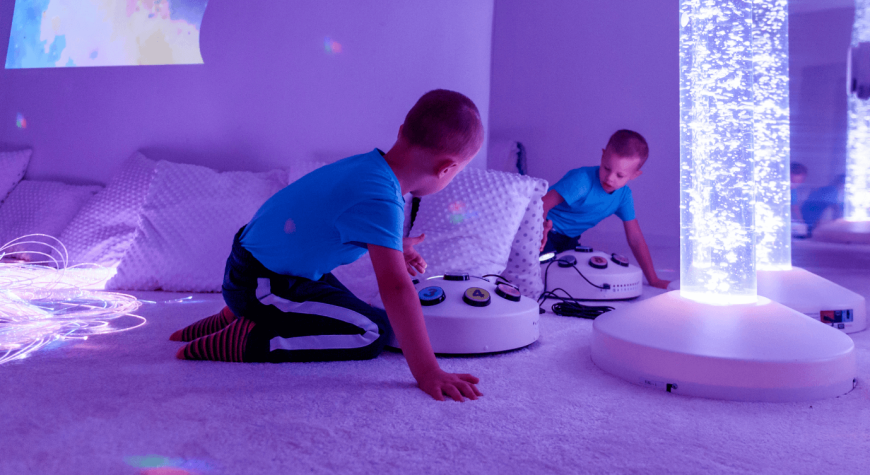Understanding Sensory Processing Disorder and Occupational Therapy

Have you ever experienced yourself cringing at a particular type of sound or found your child get agitated at some types of stimulation like light or sound stimulation? While it is normal to experience this sometimes, over sensitivity to such sensory stimulation could be a symptom of underlying sensory disorder. This condition is called Sensory Processing Disorder (SPD)
Understanding SPD and the role of Occupational Therapy (OT) in managing it can be a game-changer for those affected and their families. In this article, we will explain SPD in detail, how it manifests, and how Occupational Therapy can help.
What is Sensory Processing Disorder?
Sensory Processing Disorder is a condition where the brain has trouble receiving and responding to information that comes in through the senses. It’s not just about being overly sensitive; it can also involve under-sensitivity, where an individual might not feel pain or need intense sensory input to function. SPD can affect anyone but is particularly common among children, especially those with autism.
Children with SPD might be seen avoiding certain textures, sounds, or lights, or conversely, they may seek out sensory experiences more than others. For example, they might prefer to spin endlessly or touch everything in their environment. These behaviours are not just quirks but are deeply rooted in how their brains process sensory information.
The Role of Occupational Therapy in Managing SPD
Occupational Therapists work to create individualized programs tailored to the child’s specific sensory needs. They might use activities that involve deep pressure, movement, or tactile input to help the child become more accustomed to different sensory experiences. The goal is to gradually increase the child’s tolerance and ability to cope with sensory input in their daily lives.
Once the challenges are identified, the OT creates a personalized treatment plan to address the specific needs. Here are some key strategies employed by OTs:
- Sensory Integration Activities: Through carefully designed play activities and exercises, OTs help children integrate sensory information more effectively. This could involve activities that promote balance, coordination, and spatial awareness. For example, a child who is oversensitive to touch might benefit from activities that involve textures they initially find unpleasant, gradually increasing tolerance.
- Sensory Diets: An OT might create a sensory diet, a personalized routine of activities that provide the child with the sensory input they need to feel calm and regulated. This could include activities that provide deep pressure (firm hugs, weighted vests) or proprioceptive input (heavy work like pushing and pulling).
- Environmental Modifications: OTs can recommend modifications to the child’s environment to optimize sensory input. This might involve using noise-canceling headphones in loud environments, providing fidget toys for tactile input, or adjusting lighting for visual sensitivities.
- Self-Regulation Techniques: The OT can teach children self-regulation strategies to manage overwhelming sensory experiences. This could involve breathing exercises, mindfulness techniques, or relaxation skills.
Real-Life Impact of Occupational Therapy on SPD
Asma’s Story
Take Asma, a five-year-old girl who couldn’t stand the feel of certain fabrics and would often meltdown in noisy environments. Through Occupational Therapy, Emily learned to manage her sensory sensitivities. Her therapist introduced her to a variety of textures in a controlled, gradual way, and used noise-cancelling headphones to help her cope with loud sounds. Over time, Asma’s tolerance improved, and she became more comfortable in her environment.
Philips Story
Philip, an eight-year-old boy, was the opposite; he craved intense sensory input. He would often jump off high surfaces or crash into walls to get the sensory feedback he needed. His Occupational Therapist introduced him to safe, structured activities like trampoline jumping and heavy lifting, which provided the sensory input he craved. Philip learned to channel his needs into safer activities, reducing his risk of injury and improving his ability to focus in school.
FAQs
What are common signs of SPD?
Children with SPD might display unusual responses to sensory stimuli. They could be overly sensitive to lights, sounds, and textures or might seek out intense sensory experiences. Other signs include difficulty with coordination, poor balance, and being easily overwhelmed by sensory input.
At what age can SPD be diagnosed?
SPD can be identified as early as infancy, but it’s often diagnosed in preschool or early school-age children. Early intervention is crucial in managing SPD effectively.
How long does Occupational Therapy take to see results?
The duration of therapy varies depending on the child’s needs and the severity of their symptoms. Some children may see improvements within a few months, while others might require longer-term therapy. Consistency and parental involvement are key to the success of the therapy.
Can SPD be cured?
SPD is a lifelong condition, but with the right strategies and interventions, individuals can learn to manage their symptoms effectively. Occupational Therapy helps them develop coping mechanisms and improve their daily functioning.
Is SPD related to autism?
While SPD is common among children with autism, not all children with SPD have autism. SPD can occur independently and affects children across the developmental spectrum.
Sensory Processing Disorder can make everyday activities a challenge, but with the right support, children with SPD can lead fulfilling lives. Occupational Therapy offers a tailored approach to help these children navigate their sensory world more comfortably. By understanding SPD and the benefits of OT, parents and caregivers can better support their children on their journey to independence.

One Comment
dua66game
December 5, 2025 @ 10:35 pmJust signed up for dua66game! The interface looks slick. Hope the games are good too!. Check it out dua66game.